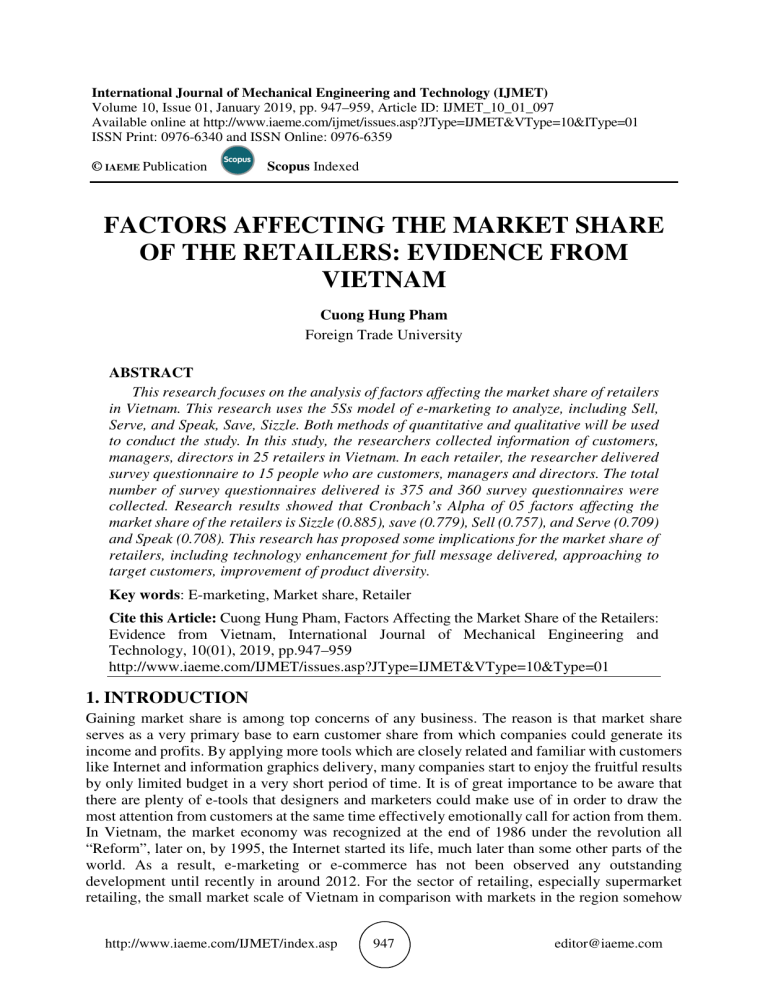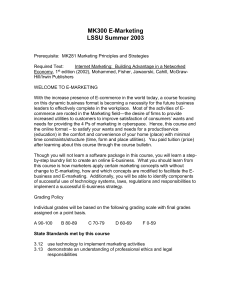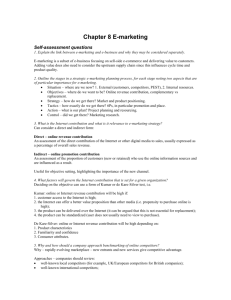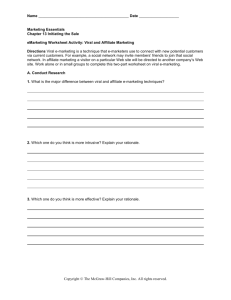FACTORS AFFECTING THE MARKET SHARE OF THE RETAILERS: EVIDENCE FROM VIETNAM
advertisement

International Journal of Mechanical Engineering and Technology (IJMET) Volume 10, Issue 01, January 2019, pp. 947–959, Article ID: IJMET_10_01_097 Available online at http://www.iaeme.com/ijmet/issues.asp?JType=IJMET&VType=10&IType=01 ISSN Print: 0976-6340 and ISSN Online: 0976-6359 © IAEME Publication Scopus Indexed FACTORS AFFECTING THE MARKET SHARE OF THE RETAILERS: EVIDENCE FROM VIETNAM Cuong Hung Pham Foreign Trade University ABSTRACT This research focuses on the analysis of factors affecting the market share of retailers in Vietnam. This research uses the 5Ss model of e-marketing to analyze, including Sell, Serve, and Speak, Save, Sizzle. Both methods of quantitative and qualitative will be used to conduct the study. In this study, the researchers collected information of customers, managers, directors in 25 retailers in Vietnam. In each retailer, the researcher delivered survey questionnaire to 15 people who are customers, managers and directors. The total number of survey questionnaires delivered is 375 and 360 survey questionnaires were collected. Research results showed that Cronbach’s Alpha of 05 factors affecting the market share of the retailers is Sizzle (0.885), save (0.779), Sell (0.757), and Serve (0.709) and Speak (0.708). This research has proposed some implications for the market share of retailers, including technology enhancement for full message delivered, approaching to target customers, improvement of product diversity. Key words: E-marketing, Market share, Retailer Cite this Article: Cuong Hung Pham, Factors Affecting the Market Share of the Retailers: Evidence from Vietnam, International Journal of Mechanical Engineering and Technology, 10(01), 2019, pp.947–959 http://www.iaeme.com/IJMET/issues.asp?JType=IJMET&VType=10&Type=01 1. INTRODUCTION Gaining market share is among top concerns of any business. The reason is that market share serves as a very primary base to earn customer share from which companies could generate its income and profits. By applying more tools which are closely related and familiar with customers like Internet and information graphics delivery, many companies start to enjoy the fruitful results by only limited budget in a very short period of time. It is of great importance to be aware that there are plenty of e-tools that designers and marketers could make use of in order to draw the most attention from customers at the same time effectively emotionally call for action from them. In Vietnam, the market economy was recognized at the end of 1986 under the revolution all “Reform”, later on, by 1995, the Internet started its life, much later than some other parts of the world. As a result, e-marketing or e-commerce has not been observed any outstanding development until recently in around 2012. For the sector of retailing, especially supermarket retailing, the small market scale of Vietnam in comparison with markets in the region somehow http://www.iaeme.com/IJMET/index.asp 947 editor@iaeme.com Cuong Hung Pham restricts its full growth and serious investment for further penetration. However, there are basic elements for a potential development in Vietnam such as: big population with mainly young population, high rate of economic potential, good speed of infrastructure and business environment improvement and non-stop improved living standard. All of the mentioned factors would strongly support the coming stage of development in retailing market, which, in Vietnam, has been recognized as enormous potential. In Vietnam, especially in big key cities like Ho Chi Minh City, there is a big completion between domestic players like Co-op mart, Citimart, Maximart, and international Retailing Corporation like Metro Cash and Carry, Lotte, Big C and etc. The completion is even getting stronger when small shopping store chain are now mushrooming, Shop and Go, B’s mart, Circle K, to name a few. These retailers are trying their best to attract as many market share as possible. All the retailers in Vietnam nowadays have to face a fierce full competition in the retailing market. The competition not only comes from local supermarket but also come from foreign ones. How to increase the market share of each retailer in this condition has been a rather difficult mathematic matter for nearly all managers. 2. LITERATURE REVIEW 2.1 Internet Marketing Internet marketing is a part of business representing lots of opportunities (Chaffy, 2008), when customer wants to order something, they have a wide selection of choice for them. According to Kotler (2005) on marketing “The internet will create the new winners and burry the laggard” the network marketing is one of the very important tools to improve your business. In Internet Marketing, it is especially beneficial to use social media as a marketing tool. Social media are used by everyone and as the owner of a company, no one would like to fall behind their competitors. There are basically four reasons to use social media as a marketing tool: communication, education, collaboration and entertainment. Internet Marketing provides an effective medium for directly communicating with customers by initiating the conversation yourself. With the support of Search engines, the distance between brands and customers are getting closer and the interaction becomes more frequent. Besides, Internet Marketing could take advantage of words, motions, technology and the refined mixture of colors and sounds to educate a large portion of perspective customers about the company and its missions/core value and its services/products. Furthermore, the collaboration of multiple websites does increase the brand awareness by expanding the banner and clicks to different sources. Finally, to create special interest in the company, Internet Marketing could provide many tools to satisfy potential customers with exciting entertaining visual and hearing effect. Marketing is defined as a social and managerial process by which individuals and groups obtain what they need and want through creating and exchanging products and value with others. The process by which companies create value for customers and build strong customer relationships in order to capture value from customers in return. Electronic marketing is the marketing side of ecommerce – company efforts to communicate about, promote and sell products and services over the Internet. 2.2. E-marketing Models For the field of e-marketing, there are different models set by different researchers and economists, for example: 4 pillar E-marketing by Ivan Surjanovic and Dragan Varagic (2003), the SOSTA by Smith and Chaffey (2005) and 5Ss of E-marketing by Smith and Chaffey (2005). 4 Pillars E-marketing is considered to be the usage of the most effective Internet marketing technology and tactics based on the needs of customers in particular. This model is used to link the direct response effects of a concrete e-marketing strategy with the factors of online branding strategy. This model can be used as a bridge between direct response strategy and online branding strategy. Another name for 4 Pillars E-marketing is 4C e-marketing strategy which can be defined http://www.iaeme.com/IJMET/index.asp 948 editor@iaeme.com Factors Affecting the Market Share of the Retailers: Evidence from Vietnam as following: (1) content: Each website has its own unique content which facilitates direct and indirect effects of the organization’s online image and presence. The Unique Selling Point of each website is the key success to its original concept where the content fulfils the online goals. (2) Click Stream: It is the observation of all users’ activities when users enter or visit the website, such as: where is he/she from? What is his/her gender? Clickstream helps improve the interaction in the website effectively. The precise analysis of user’s behavior on the website represents the strongest weapon of an online presence. (3) Communication: users can have a chat or communication with the admin of the website to get more information they need. Chat functionality, other communication tools with the appropriate use are able to magnify the most wanted response of the website. (4) Conversion: Using effectively the first three pillars of Internet marketing strategy, the result should be better direct effects (the conversion from visitors to customers). The goal of this online strategy element is to additionally improve the Web site conversion. SOSTA is the popular planning model developed in the 1990s to make plans for different planning activities. The analysis on Marketplace SWOT including 5 S’s performance and other KPI’s, customer insight, market trends, competitor, internal capabilities and resources. Objectives – Where do we want to be? Determination of 5 S’s objectives including Sell (customer acquisition and retention targets), Serve (customer satisfaction targets), Sizzle (the added value), Speak (engaging customers) and Save (quantified efficiency). Strategy – How do we get there? After stating objectives for the plan, STOPS (Segments – Target markets – Objectives – Positioning) and SIT (Sequence – Integration – Targeting and segmentation) are elements in need to be analyzed. Tactics – How exactly do we get there? Consideration of Marketing mix (8 P’s, Incl. Communication Mix, Content Plan, and Contact Plan). Actions – The details of tactics: Determination of who does what and when (responsibilities and structures, processes and systems, internal resources and skills, external agencies). 5S’ model: In general, companies need and develop e-marketing because of different purposes, Smith and Chaffey (2005) established or create 5Ss of e-marketing which states five outstanding benefits or reasons for applying e-marketing into the business which marketers can utilize to set up their all business goals. 3. RESEARCH METHODOLOGY 3.1. Research framework The research uses the E-marketing model set by Smith and Chaffey (2005) which is called 5Ss E-marketing model. The 5Ss include: Sell, Serve, Speak, Save and Sizzle. These 5Ss affect the market share of retailers in the market. http://www.iaeme.com/IJMET/index.asp 949 editor@iaeme.com Cuong Hung Pham Diagram 1: 5Ss E-marketing model 3.2. Research methodology In this paper, the researcher uses both quantitative and qualitative to collect and analyze the data. For the main purpose of research, both methods of quantitative and qualitative will be used to conduct the study. According to Cooper & Schindler (2006) and Kuhn (1961), qquantitative methodologies are used to measure consumer behaviors, knowledge, opinions, or attitudes in almost business research. Denzin & Lincoln (2005) argued that qqualitative methods aim to gather an in-depth knowledge of consumer behaviors. Qualitative methods provide the detailed results that offer many ideas and concepts to inform the program (Merriam, 2009). This method mainly focuses in investigating why and how to make decision. Smaller but focused samples are more often used than large samples. The most common tools used in qualitative market research are focus groups and individual in-depth interviews. In modern research, most psychologists tend to adopt a combination of qualitative and quantitative approaches. This ensures statistically reliable information obtained from numerical measurement to be backed up by as well as enriched by the information about the research participants' explanations. 3.3. Population and Sampling Local customers, managers, directors of retailers, business competitors who are specialists in the field of E-marketing activities in Vietnam take part in this research. According to Cooper and Emory (1995), sampling is a selecting part of elements in a population. It results in the fact that conclusions from the population may be generalized to that about the entire population. In this study, the researchers collected information of customers, managers, directors in 25 retailers in Vietnam. In each retailer, the researcher delivered survey questionnaire to 15 people who are customers, managers and directors. The total number of survey questionnaires delivered is 375 and 360 survey questionnaire were collected. Among these, 345 were accepted with 15 survey questionnaires were not accepted because of wrong choice to some items. The respondents are both female and male respondents. http://www.iaeme.com/IJMET/index.asp 950 editor@iaeme.com Factors Affecting the Market Share of the Retailers: Evidence from Vietnam 3.4. Data instrument collection 3.4.1. Qualitative method: Using in-depth interview The researcher firstly conducted the in-depth interview with managers, directors and customers of retailers in Vietnam to discover and explore the e-marketing critical factors affected the market share of retailers. Among them are 3 customers, 2 managers and directors so the total number of respondents in each retailer. 3.4.2. Quantitative method: survey questionnaire For the survey questionnaire, there are two main parts which are: Personal information and Benefits of E-marketing implementation used by retailer. Part 1 which is related to Personal information include: age group, gender, job title, level of education. Part 2 which is related to 5Ss model of E-marketing consists of five different letter S (Sell, Serve, Speak, Save, and Sizzle). In each letter S, there are even smaller items aiming at to get more data for the research. The number of items and types of variable are displayed in Table 1. Table 1: Variables of the Study Variables Type of variable Items number in each variable Sell Independent 05 (Sel1- Sel5) Serve Independent 04 (Ser1-Ser4) Speak Independent 05 (Spe1-Spe5) Save Independent 05 (Sav1-Sav5) Sizzle Independent 04 (Siz1-Siz4) All items in the survey questionnaire are based on five dimensions mentioned clearly in 5Ss E-marketing model. There are 23 smaller items in the 5Ss E-marketing model together. For these parts, respondents answer the survey questionnaire by choosing from 1 to 5 (equivalent to strongly disagree to strongly agree in Likert scale). The language was both English to ease respondents’ comprehension and responses. 3.5. Validity and Reliability 3.5.1. Reliability According to Cronbach (1946), the calculating of coefficient alpha assesses the reliability of multipoint-scale items. If the coefficients are higher, the measuring instrument is better. Cronbach (1946) also argued that the coefficient should be at 0.7 or higher. In this research, the Cronbach’s Alpha was calculated for Sell, Serve, Speak, Save and Sizzle of E-Marketing activities. 3.5.2. Validity The validity was set up by the assistance and great support of the key managers and directors from retailer in Vietnam to comment on content, construct, measurement and format of questionnaire to pass judgment on the suitability of the items chosen before conducting the survey. In order to develop questionnaires, a pilot survey will be conducted by delivering survey questionnaire to managers, directors and customers of 5 different retailers in Vietnam. 3.5.3. Data analysis procedure The researcher used the software SPSS 16.0 to analyze the data collected from the survey questionnaire and in-depth interview with a purpose to test the hypothesis and test the overall framework of the research. SPSS 16.0 was used as following details: (1) Descriptive statistics http://www.iaeme.com/IJMET/index.asp 951 editor@iaeme.com Cuong Hung Pham analysis: help understand and master the features and characteristics of dependent and independent variables. (2) Factor analysis: both dependent and independent variables were analyzed to identify the underlying variables which make up and calculate the correlations between items and factors. (3) Reliability analysis: Every single factor was tested the reliability analysis to make sure the internal consistency of each variable. Reliability refers to the internal consistency of items that measure a latent construct. Internal consistent items form a homogeneous set in that they vary together statistically. Reliability was measured by Cronbach’s coefficient alpha (Cronbach, 1951). 4. RESEARCH RESULTS 4.1. Descriptive statistics In-depth interview: The sample size of the interview was 50 people. Among these 50 respondents, 30 were customers, 20 were managers and directors. For the age group, more than half of the interviewees are between 30 and 40 years old, representing 54% for the whole interview group. Of all 50 interviewees, 29 are female interviewees making up 58%. For the qualification of the respondents, more than half of them got College or University degree (62%) whereas 6 people even got higher education like a Master or PhD degree. Table 2: In-Depth Respondents’ Demographics Age group Valid Gender Valid Under 30yrs 30 -40 yrs 41-50 yrs Total Frequency 12 27 11 50 Percent 24 54 22 100 Valid Percent 24 54 22 100 Male Female Total 21 29 50 42 58 100 42 58 100 High school degree College, University degree Higher education degree Total 13 31 6 50 26 62 12 100 26 62 12 100 staff, officer, teacher Manager Board of Director Total 19 7 24 50 38 14 48 100 38 14 48 100 High school University graduate Postgraduate studies Total 6 35 9 50 83.3 16.7 100 83.3 16.7 100 Qualification Job Valid Education Valid Official survey: The sample size of the survey was 375. After the survey, 345 questionnaires were collected during the scheduled time, accounting for 92%. All questionnaires are legal for the analysis. Table 3 shows the demographic characteristics of respondents of this study. http://www.iaeme.com/IJMET/index.asp 952 editor@iaeme.com Factors Affecting the Market Share of the Retailers: Evidence from Vietnam Table 3: Respondents’ Demographics Age Category Valid Gender Valid Under 30yrs 30 -40 yrs 41-50 yrs Over 51 yrs Total Frequency 97 168 57 23 345 Percent 27.3 56 12 4.7 100 Valid Percent 27.3 56 12 4.7 100 Male Female Total 138 207 345 56 44 100 56 44 100 69 208 14.7 61.3 14.7 61.3 68 24 24 345 100 100 Job Valid Education Valid staff, officer, teacher Manager Board of Director Total High school University graduate Postgraduate studies Total 263 57 25 345 4.2. Measurement results of research variables Twenty three items of the survey questionnaire are showed clearly in Table 4 representing the outcomes of descriptive analysis. Means of twenty three items ranged from 3.3733 to 4.3533. The lowest means is of the item: “Increase interaction with different content” and the highest means are of the items: “Grow your sales”. Table Error! No text of specified style in document.: Descriptive Statistics of Twenty-Four Measured Items Variables N Mean Sel1. Target a broader audience through online marketing Sel2. Grow your sales Sel3. Show more products Sel4. Sell more products Sel5. More audience can visit web shop Ser1. Create additional benefits Ser2. Faster customer service Ser3. Serve more customers Ser4. Increase interaction with different content Spe1. Providing content that can be accessed from work Spe2. Providing content that can be accessed from home Spe3. Skype, yahoo, or email will help 345 345 345 345 345 345 345 345 345 345 345 345 4.2733 4.3533 3.8667 3.4333 3.9067 3.9467 3.9067 3.8400 3.3733 3.9267 4.0933 3.9333 http://www.iaeme.com/IJMET/index.asp 953 Std. Deviation .64399 .75206 .70155 .78933 .66903 .54078 .57167 .54440 .60807 .84422 .71744 .62031 editor@iaeme.com Cuong Hung Pham Spe4. Get closer to your customers Spe5. Also through website Sav1. Reduce cost for employee fee Sav2. Reduce postage cost Sav3. Reduce printing cost Sav4. Save time Sav5. Increase web self – service Siz1. Improve brand awareness Siz2. Provide the new proposition Siz3. Gain more experience Siz4. Extend the market Goal of implementing E-Marketing is to Improve Sales 345 345 345 345 345 345 345 345 345 345 345 345 3.6200 3.6800 3.8467 3.5867 3.4400 3.7200 3.7133 3.7800 3.8533 3.8733 3.7933 3.8533 .75680 .92192 .85716 .73445 .61829 .70587 .93648 .74067 .56028 .57108 .55920 .69886 Central tendency with mean calculation and the measure of dispersion with standard deviation calculation were done for five constructs: Sell, Serve, Speak, Save and Sizzle as in Tables 5, 6, 7, 8, 9. Table 5: Means and Standard Deviations of Sell Variables Mean Sel1. Target a broader audience through online marketing Sel2. Grow your sales Sel3. Show more products Sel4. Sell more products Sel5. More audience can visit web shop Sell 4.2733 4.3533 3.8667 3.4333 3.9067 3.9667 Std. Deviation .64399 .75206 .70155 .78933 .66903 .7112 Sell variable of E-Marketing strategy is assessed highest among other with the mean of 3.9667, all items were from 3.4333 and above. The lowest mean was of the item “Sell more products” and the performance of the “Grow your sales” is perceived highest (4.3533). Table 6: Means and Standard Deviations of Serve Variables Mean Ser1. Create additional benefits Ser2. Faster customer service Ser3. Serve more customers Ser4. Increase interaction with different content Serve 3.9467 3.9067 3.8400 3.3733 3.7668 Std. Deviation .54078 .57167 .54440 .60807 .56623 The total mean of Serve was lower than those of Speak variables (3.7668). Among the four small items of Serve, the “Increase interaction with different content” is assessed lowest with the mean of 3.3733. http://www.iaeme.com/IJMET/index.asp 954 editor@iaeme.com Factors Affecting the Market Share of the Retailers: Evidence from Vietnam Table 7: Means and Standard Deviations of Speak Variables Mean Spe1. Providing content that can be accessed from work Spe2. Providing content that can be accessed from home Spe3. Skype, yahoo, or email will help Spe4. Get closer to your customers Spe5. Also through website Speak 3.9267 4.0933 3.9333 3.6200 3.6800 3.8507 Std. Deviation .84422 .71744 .62031 .75680 .92192 .77214 The total mean of Speak variable is 3.8507. In the five items of Speak, the item “Get closer to your customers” is evaluated lowest with the mean of 3.62. Table 8: Means and Standard Deviations of Save Variables Mean Sav1. Reduce cost for employee fee Sav2. Reduce postage cost Sav3. Reduce printing cost Sav4. Save time Sav5. Increase web self – service Save 3.8467 3.5867 3.4400 3.7200 3.7133 3.6613 Std. Deviation .85716 .73445 .61829 .70587 .93648 .77045 The Save in E-Marketing strategy is perceived as the lowest mean in five constructs with the mean of 3.6613. There were no items higher than 3.8467, in which the “Reduce printing cost” is assessed lowest (3.44). Table 9: Means and Standard Deviations of Sizzle Variables Mean Siz1. Improve brand awareness Siz2. Provide the new proposition Siz3. Gain more experience Siz4. Extend the market Sizzle 3.7800 3.8533 3.8733 3.7933 3.8250 Std. Deviation .74067 .56028 .57108 .55920 .60781 The total mean of Sizzle in E-Marketing strategy is 3.8250. In four items of the Sizzle construct, enterprises perceived the “Improve brand awareness” as the lowest rate (3.78), then the Extend the market (3.7933). 4.3. Reliability Cronbach's Alpha is a statistical test used to examine the correlation between variables. There are two aspects related which are the relationship between the variables themselves and correlation of the scores of each variable with a score of all the variables of each respond. Moreover, it is a statistical test used to examine the correlation between variables. This method allows the analyzer remove the unsuitable variables and spam variables in the model. Accordingly, only those variables with Cronbach’s Alpha greater than 0.6 are accepted and appropriate to include the next step. Results of reliability were showed in table 10, 11. http://www.iaeme.com/IJMET/index.asp 955 editor@iaeme.com Cuong Hung Pham Table 10: Cronbach’s Alpha of Total- Item Statistics Variables Cronbach's Alpha of Sell Sel1. Target a broader audience through online marketing Sel2. Grow your sales Sel3. Show more products Sel4. Sell more products Sel5. More audience can visit web shop Cronbach's Alpha of Serve Ser1. Create additional benefits Ser2. Faster customer service Ser3. Serve more customers Ser4. Increase interaction with different content Cronbach's Alpha of Speak Spe1. Providing content that can be accessed from work Spe2. Providing content that can be accessed from home Spe3. Skype, yahoo, or email will help Spe4. Get closer to your customers Spe5. Also through website Cronbach's Alpha of Save Sav1. Reduce cost for employee fee Sav2. Reduce postage cost Sav3. Reduce printing cost Sav4. Save time Sav5. Increase web self – service Cronbach's Alpha of Sizzle Siz1. Improve brand awareness Siz2. Provide the new proposition Siz3. Gain more experience Siz4. Extend the market Goal of implementing E-Marketing is to Improve Sales Cronbach's Alpha if Item Deleted .702 .632 .610 .612 .627 .757 .709 .659 .608 .580 .730 .701 .620 .591 .672 .664 .708 .701 .719 .691 .779 .730 .677 .885 .829 .835 .851 .887 .705 Table 10 shows Cronbach's Alpha for each variable of Sell, Serve, Speak, Save and Sizzle. For the Serve and Sizzle variables, since all the Cronbach’s Alpha are greater than 0.6 and the figure in the Cronbach’s Alpha if item deleted not much difference so all factors and variables are accepted. In the Sell variable, the researcher found that if deleted Sel5, the Cronbach’s Alpha will be higher at .757. As well as Speak and save variables, the Cronbach’s Alpha will be at .708 and .779 in turn if Spe5 and Sav3 deleted. To be higher in Cronbach’s Alpha, the researcher decides to remove “Sel5. More audience can visit webshop”, “Spe5. Also through website” and “Sav3. Reduce printing cost”. Table 11 shows the final Cronbach’s Alpha for each variable. http://www.iaeme.com/IJMET/index.asp 956 editor@iaeme.com Factors Affecting the Market Share of the Retailers: Evidence from Vietnam Table 11: Cronbach’s Alpha of Five Constructs Variables Sell Serve Speak Save Sizzle Total Cronbach's Alpha .757 .709 .708 .779 .885 .705 N of Items 4 4 4 4 4 20 5. IMPLICATIONS 5.1. Technology enhancement for full message delivered Although there has been observed a big and dramatic change in term of technology, especially that relating to informatics or high technology, the application of e-marketing which could provide the fast speed of processing and security in transaction remains a question for most of business owner. Besides, the habit of approach shopping channels via traditional market (usually wet or open market) still exists and portion of housewives going shopping online are limited. The national information systems or infrastructure, although great achievement has been achieved, is still unable to ensure a capable network for promoting online shopping or services, among which e-commerce is quite a big question. According to international experts, Vietnam’s IT has lagged behind the region for several decades. While Thailand and Indonesia have nearly 200 Internet Service Providers (ISPs) and the number in Malaysia has reached 100, Vietnam only pause at very few. Nevertheless, it could be seen that after the process of renovation, Vietnam has successfully implemented its modernization and speeding strategy in the Information and Communication Technology industry, achieving great process in terms of technology and service development. So far in 2018, Vietnam did strongly adjust its strategy to meet its new goals for the development of Information Community Technology and the country as a whole. The most important thing to keep in mind when conducting internet marketing is about technology. While interacting with customers indirectly, the color and all illustration and display should be taken good care to ensure the message would be delivered fully and completely in the most convenient and understandable way. Therefore, to overcome the problems of display and interaction with customers, especially to increase the competitiveness and gain market share against foreign competitors, retailers should strongly take into consideration of building up an excellent technology via agencies. 5.2. Approaching to target customers The research carried out announced that about 80% of Vietnamese consumers believed in advertisements but this percentage have kept on decreasing as time passes. Although the number of internet users increases every year, most of the users now has their purposes like what follows (Cimigo NetCitizen, 2016) http://www.iaeme.com/IJMET/index.asp 957 editor@iaeme.com Cuong Hung Pham Figure 1: Internet users' purposes It could be seen that online-shopping has not been familiar with Vietnamese buyers and the task of applying e-marketing should start with educating customers about the convenience and exciting experience of online-shopping. This will in turn increase the visits of shoppers to retailer websites and helps enhance the brand awareness and preference. The use of pop-up tools and email marketing could be taken into consideration in this case. Pop-up could easily attract customer’s attention through its high interactive level and beautiful display plus the widespread impacts of e-mail marketing, the results could be impressive within only a short period of time. 5.3. Improvement of product diversity The advantage of modern trade over traditional trade is its diversification in products. Especially in this case, where retailer would like to make use of e-marketing to target larger portion of customers available, retailer should pay more attention to product diversity. There are three primary reasons for this. First, while shopping online, customers are rarely impacted by display like what they are at the supermarkets and so far there is rarely any modern trade channel in Vietnam providing online shoppers with such satisfactory visual experience. Thus, retailer should make sure to deliver the massage of product diversity towards their customers. Basically the shoppers are individual customers; they tend to switch easily from one supplier to another. If there is of any chance that their needs could not be satisfied, retailer will lose its customers leading to the drop in sales and market share. Besides, e-marketing with its tools and engines would partly pop-up some advertisements to notify visitors upon the wide range of products available. Also, by linking to some most popular websites or forums designed for housewives or online shoppers and search engines, retailer could also spread out its brand and convenience. http://www.iaeme.com/IJMET/index.asp 958 editor@iaeme.com Factors Affecting the Market Share of the Retailers: Evidence from Vietnam REFERENCES [1] [2] [3] [4] [5] [6] [7] [8] [9] [10] [11] [12] [13] [14] [15] [16] [17] [18] [19] [20] [21] Baker, M.J. (2007). The marketing book. Edition: 5, Butterworth-Heinemann. Bitner, J. en Booms, B. "Marketing strategies and organizational structures for service firms", in Donnelly, J. en George, W. (1981). Marketing of services, American Marketing Association, Chicago. Brown, B.C. (2006). How to use the Internet to advertise, promote and market your business or Web site- with little or no money, Atlantic Publishing Company. Chaffey D., Paul, S. (2008). E-Marketing Excellence: Planning and Optimizing Your Digital Marketing, Chartered Institute of Marketing Edition: 3, illustrated Published by ButterworthHeinemann. Chaffey, D., & Smith, P. R. (2005). E-Marketing excellence: The heart of eBusiness (2nd ed.). Oxford: Elsevier Butterworth-Heinemann. Chaffey, D., Ellis-Chadwick, F., Johnston, K. & Mayer, R. (2006). Internet Marketing: Strategy, Implementation and Practice (3rd ed.). Harlow, UK: Pearson Education Limited. Cooper Donald R., Emory C. William. (1995) 5th ed. “Business Research Methods”. Richard D. Irwin, INC. Cooper, D. R., & Schindler, P. S. (2006). Business Research Methods (9th, ed.) pp.198. New York: The MacGraw-Hill. Cronbach L. J. (1946). Response sets and test validity. Educational & Psychological Measurement, 6, pp. 475-494 Deming W.E.. (1960) “Sample Design in Business Research” . New York: John Wiley & Sons. Ivan Surjanovic and Dragan Varagic. 2003. The 4 Pillars Internet Marketing Strategy. www.ipowerstrategy.com Kotler, P. (2003). Marketing Essentials. Northwestern University Kuhn, T. S. (1961). The Function of Measurement in Modern Physical Science. Isis, 52(2), 161-193. Laudon, K.C., Traver, C.V. (2010). E-Commerce. New Jersey : Prentice Hall, Seventh Edition. Merriam, S. (2009). Qualitative research: A guide to design and implementation. San Francisco, CA: Jossey-Bass. Mohammed, R., Robert J. F., Bernard J. J., Paddison, G. (2003). Internet Marketing, 2/e, with E-Commerce Power Web Edition: 2, revised Published by McGraw-Hill Moran, M. & Hunt, B. (2006). Search engine marketing, Inc: driving search traffic to your company’s web site. Upper Saddle River, N.J.: IBM; London: Pearson Education (Distributor). Rhee, Y. (2004). An Overview of Public Relations Theory, University of Maryland, College Park. Smith, P., Berry, C., Pulford, A. (1999). Strategic marketing communications: new ways to build and integrate communications, Published by Kogan Page Publishers. Smith, P.R. and Chaffey, D. (2005). E-Marketing excellence: at the heart of e-Business. 2nd ed. Butterworth Heinemann, Oxford, UK. Smith, P.R. and Chaffey, D. (2005). E-Marketing excellence: at the heart of e-Business. 2nd ed. Butterworth Heinemann, Oxford, UK. http://www.iaeme.com/IJMET/index.asp 959 editor@iaeme.com





